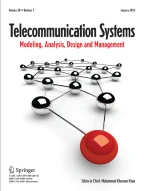Abstract
A response function is usually used to describe the scalability of a protocol for high-speed network. This requires detailed knowledge of the time-domain sending rate. However, studies about the performance of eXplicit Control Protocol (XCP) mainly focus on the steady-state behavior and few address this problem. Under a model with single bottleneck, the time-domain sending rate of XCP is derived in this paper. Simulation results show that this analytic time-domain sending rate is accurate. Combined with a periodic loss model, the response function of XCP is further derived. Unlike response functions of other protocols, the response function of XCP is related to not only the loss event rate, but also the per-flow bandwidth. Simulation results show that it forms an upper bound for the throughput of XCP with given loss event rate and per-flow bandwidth.
Similar content being viewed by others
Explore related subjects
Discover the latest articles, news and stories from top researchers in related subjects.References
Floyd, S. HighSpeed TCP for large congestion windows. In: RFC 3649, IETF, Dec. 2003.
Kelly, T. (2003). Scalable TCP: Improving performance in highspeed wide area networks. In: Proc. PFLDnet.
Katabi, D., Handley, M., & Rohrs, C. (2002). Internet congestion control for future high bandwidth-delay product environments. In: Proc. ACM SIGCOMM.
Jacobson, V. (1988). Congestion avoidance and control. In: Proc. ACM SIGCOMM (pp. 314–329).
Allman, M., Paxson, V., & Stevens, W. TCP Congestion Control. In: RFC 2581, IETF, Apr. 1999.
Falk, A., Pryadkin, Y., & Katabi, D. Specification for the Explicit Control Protocol (XCP). http://www.isi.edu/isi-xcp/docs/draft-falk-xcp-spec-03.txt.
Low, S. H., Andrew, L. L. H., & Wydrowski, B. P. (2005). Understanding XCP: equilibrium and fairness. In: Proc. IEEE INFOCOM.
Zhang, Y., & Ahmed, M. (2005). A control theoretic analysis of XCP. In: Proc. IEEE GLOBECOM.
Mathis, M., Semke, J., Mahdavi, J., & Ott, T. (1997). The macroscopic behavior of the TCP congestion avoidance algorithm. ACM SIGCOMM Computer Communication Review, 27(3).
The Network Simulator—ns-2, http://www.isi.edu/nsnam/ns/.
Author information
Authors and Affiliations
Corresponding author
Additional information
This research is funded by NSFC of China under grant number of 60503049/60772098/60702043, NCET of Ministry of Education of China under grant number of NCET-06-0393, National 863 Hi-Tech Research and development plan of China under grant number of 2007AA01Z455, and Shanghai dawn scholar Foundation in China. This work was performed when Chuanxiong Guo as associated with the Nanjing Institute of Communications Engineering. This work was first published in the ICCCN-PMECT’08.
Rights and permissions
About this article
Cite this article
Cheng, S., Li, J., Zhu, L. et al. Time-domain sending rate and response function of eXplicit Control Protocol. Telecommun Syst 45, 323–328 (2010). https://doi.org/10.1007/s11235-009-9270-x
Published:
Issue Date:
DOI: https://doi.org/10.1007/s11235-009-9270-x
